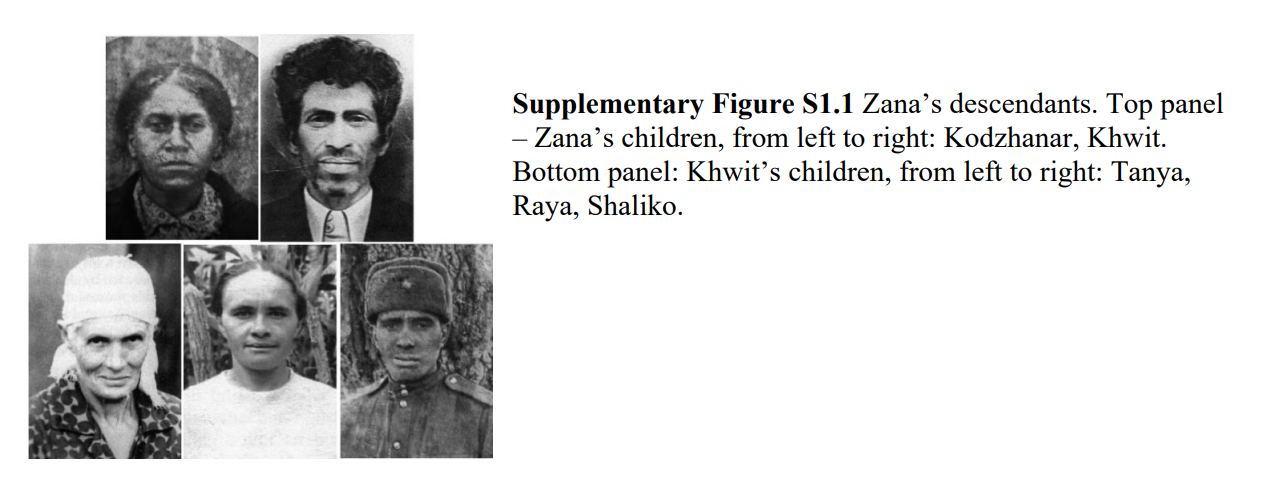AU77078
古人
hg19 / GRCh37
K47 西非 West-African: 26.50% 北高加索 North-Caucasian: 14.26% 南高加索 South-Caucasian: 14.14% 尼罗人 Nilotic: 10.59% 库施特 Kushitic: 5.16% 伊朗 Iranian: 4.58% 中地中海 Central-Med: 3.39% 萨赫勒 Sahelian: 3.13% 中非 Central-African: 2.71% 东欧 East-Euro: 2.62% 斯堪的纳维亚-日耳曼 Scando-Germanic: 2.33% 突厥-阿尔泰 Turkic-Altai: 1.79% 东北亚 NE-Asian: 1.52% 古巴尔干 Paleo-Balkan: 1.39% 北非 North-African: 1.38% 帕米尔 Pamirian: 1.17% 东非 East-African: 1.12% MichalK25 西非 West African: 38.78% 高加索 Caucasian: 21.53% 东北欧 Northeast European: 8.67% 柏柏尔人 Berberic: 5.67% 东非 East African: 3.79% 德鲁兹人 Druzian: 3.51% 中非 Central African: 2.85% 阿拉伯 Arabic: 2.38% 堪察加 Kamchatkan: 1.61% 东亚 East Asian: 1.59% 阿尔泰 Altaic: 1.58% 北印度 North Indian: 1.53% 地中海 Mediterranean: 1.49% 卡拉什人 Kalash: 1.42% 北美印第安人 North Amerindian: 1.26% K12b 撒哈拉以南非洲 Sub Saharan: 36.37% 高加索 Caucasus: 21.07% 东非 East African: 12.83% 北欧 North European: 9.71% 格德罗西亚 Gedrosia: 8.45% 西北非 Northwest African: 2.96% 东亚 East Asian: 2.76% 大西洋地中海 Atlantic Med: 2.57% 西南亚 Southwest Asian: 1.80% 西伯利亚 Siberian: 1.47% puntDNAL 撒哈拉以南非洲 Sub-Saharan: 41.59% 新石器时代安纳托利亚 Anatolian Neolithic: 17.60% 新石器时代伊朗 Iran Neolithic: 16.80% 欧洲狩猎采集者-大草原 EHG-Steppe: 8.12% 非洲狩猎采集者 African HG: 3.88% 西伯利亚 Siberian: 3.78% 西方狩猎采集者 Western HG: 2.81% 纳吐夫狩猎采集者 Natufian HG: 2.45% 东欧亚 East Eurasian: 1.28% 大洋洲 Oceanian: 1.08% 美洲印第安人 Amerinidian: 0.61% AncientNearEast13 撒哈拉以南非洲 Sub-Saharan: 44.84% 高加索狩猎采集者-早期欧洲农人 CHG-EEF: 16.50% 新石器时代伊朗 Iran-Neolithic: 11.64% 纳吐夫 Natufian: 9.85% 欧洲狩猎采集者 EHG: 6.08% 新石器时代安纳托利亚 Anatolia Neolithic: 4.22% 西伯利亚 Siberian: 2.83% 东南亚 Southeast Asian: 1.53% 斯堪的纳维亚-西欧狩猎采集者 SHG-WHG: 1.08% 巴布亚 Papuan: 0.80% 极地 Polar: 0.63%
男
覆盖度80.81% 平均深度2
科研机构
Republic of Abkhazia
MT 383C 4127A 4159T 7359A 7362A 7384A 7392A 8854A 11002G 16180G
Enigmatic phenomena have sparked the imagination of people around the globe into creating folkloric creatures. One prime example is Zana of Abkhazia (South Caucasus), a well-documented 19th century female who was captured living wild in the forest. Zana’s appearance was sufficiently unusual, that she was referred to by locals as an Almasty – the analog of Bigfoot in the Caucasus. Although the exact location of Zana’s burial site was unknown, the grave of her son, Khwit, was identified in 1971. The genomes of Khwit and alleged Zana were sequenced to an average depth of ca. 3× using ancient DNA techniques. The identical mtDNA and parent-offspring relationship between the two indicated that the unknown woman was indeed Zana. Population genomic analyses demonstrated that Zana’s immediate genetic ancestry can likely be traced to present-day East-African populations. We speculate that Zana might have had a genetic disorder such as congenital generalized hypertrichosis which could partially explain her strange behavior, the lack of speech and long body hair. Our findings elucidate Zana’s unfortunate story and provide a clear example of how prejudices of the time led to notions of cryptic hominids that are still held and transmitted by some today.


19th century
The genomic origin of Zana of Abkhazia
© 2020-2025 TheYtree.com
